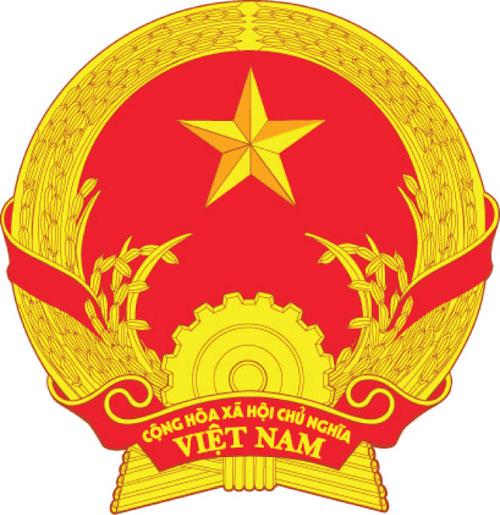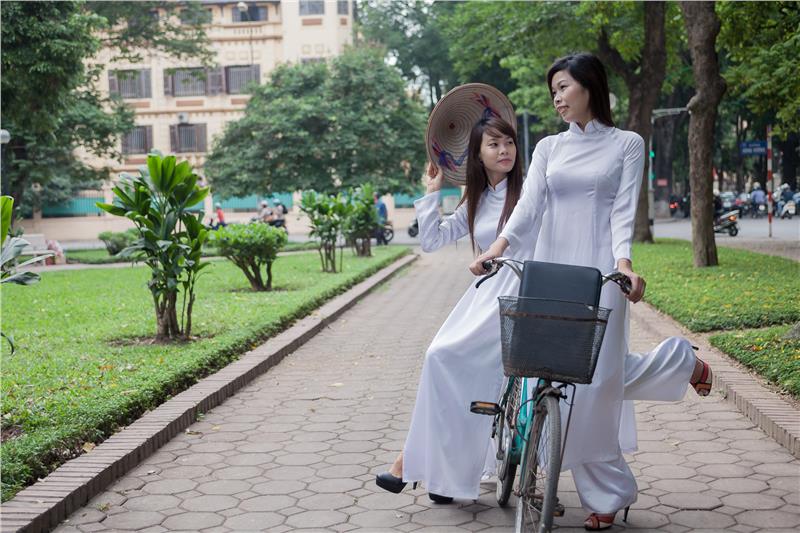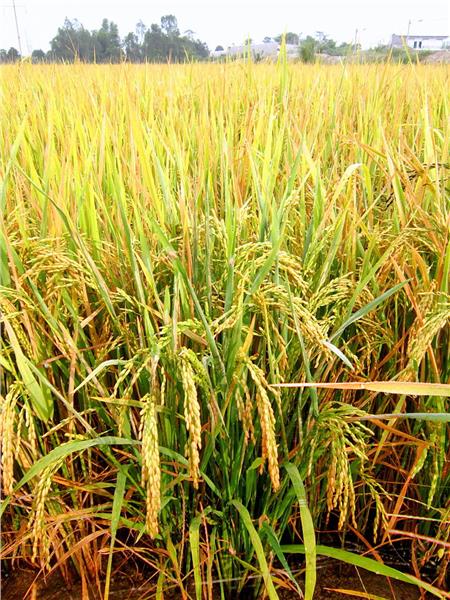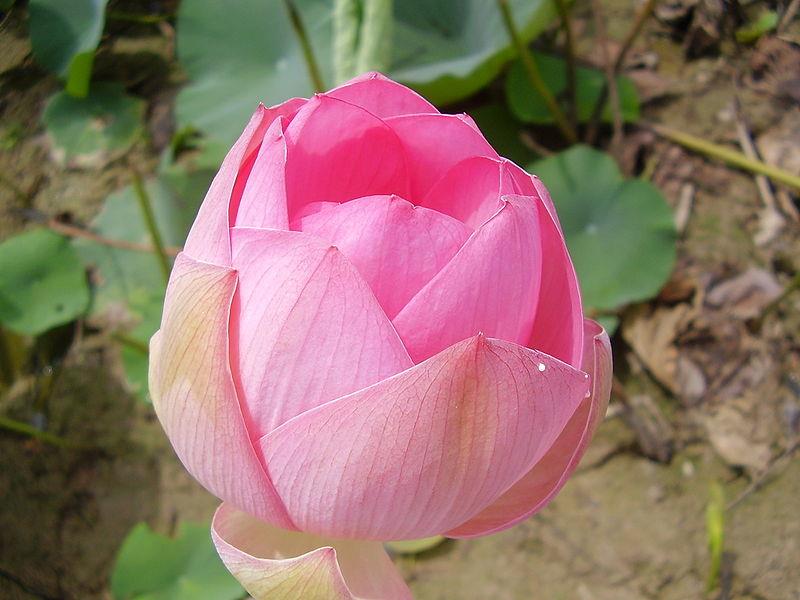
The National Emblem is the official Vietnam symbol which has been used by the Vietnamese government since 1955. The original version of the present emblem had been the allegory of the Democratic Republic of Vietnam. After the Reunification in 1975, it became the National Emblem of Vietnam. It was designed by artist Bui Trang Chuoc and edited by artist Tran Van Can. This pictorial symbol is officially used in government documents, monetary items such as coins, notes and to represent the nation in the international community as well. The State Emblem is designed in rounded shape on red background together with five-point gold star in the middle symbolizes the revolutionary history of the nation, the socialist regime led by the Communist Party in Vietnam and the bright future of the country; the rice surrounding the Emblem symbolizes the agriculture; the cogwheel symbolizes industry; and finally, at the bottom of the emblem is the title “The Socialist Republic of Vietnam” in Vietnamese as the name and political regime of this nation.

The Vietnam national flag first officially was hoisted in Ba Dinh Square on the occasion of Democratic Republic of Vietnam’s foundation in 1945 when President Ho Chi Minh read the Declaration of Independence. It is rectangular in shape, its width being equal to two-thirds of its length; in the middle of a red background is a five-pointed gold star. Red is an intense color that recalls the French revolution in the past and represents the societal revolution at present. Another meaning, it refers to the blood sacrificed by Vietnamese soldiers in their great fights against invaders. The star represents five main classes in Vietnamese society including intellectuals, farmers, workers, businessmen and militaries. It also shows the solidarity and connection of these five classes in the society. The yellow color of the star is the color of Vietnam's ethnic that also appears on other Vietnam national symbols such as the national emblem.
“Tien Quan Ca” (“Army March” in English) is the national anthem of Vietnam. It was written and composed by Văn Cao composer (1923-1995) in 1944, and was adopted as the national anthem of the Democratic Republic of Vietnam in 1945. After the end of the Vietnam War in 1976, it became the national anthem of Socialist Republic of Vietnam.

“Ao dai” (Vietnamese long dress) seems to be the most famous symbol of Vietnam culture when referring Vietnam. Early versions of “ao dai” seemed to set its presence in Vietnam from 1744. However, not until 1930 did “ao dai” appear partly similar to its look today thanks to Cat Tuong, a Vietnamese fashion designer-cum-tailor who strongly innovating an old traditional style by lengthening the top reaching the floor, fitting the bodice to the curves of the body, and moving the button line from the front to the left side of the body. In addition, two other Saigon tailors in 1950 continuously modernized this style when producing “ao dai” with raglan sleeves. This creates a diagonal seam running from the collar to the underarm and the style is still preferred today. That its body-hugging top flows over wide trousers, splits in the gown extend well above waist height makes it comfortable and easy to move in. “Ao dai” is famously known to ‘cover everything, but hide nothing’, and it perfectly accentuates the long and lithe body possessed by Vietnamese women. Yet it always keeps its traditional features of flatter the decency and harmony for those who wear it. Therefore, it is not easy at all to think of a more elegant, demure, and yet sexy attire that suits women of all ages than the symbol of Vietnamese national culture – “Ao dai”.

For Vietnamese, rice means much more than a type of staple. It has played an important role in the evolution of the society and economies. The development of the rice fields always coincides with the development of the nation. It will not be overstated to assert that rice is the most influential factor in Vietnamese traditional culture and a driving force for history. Rice is the most popular grain, which cannot be absent in any Vietnamese meals. Also, it feeds the population and contains a hidden beauty that can beautify the already elegant Vietnamese culture. Although many rice fields recently have been transformed into industrial zones, it remains an indispensable element in the images of the Vietnamese traditional villages and culture. It can be said that rice is an unofficial symbol in Vietnam culture.

Lotus flowers are beautiful in both appearance and smell. They gather near the mud but still remaining a pure and upright pleasant smell, just like Vietnamese people. Although facing with many difficulties, Vietnamese people still keep the pure and upright inside their souls. Lotus has taken deep roots in Vietnamese minds and hearts as the symbol of simplicity, hospitality and purity. Also, the lotus represents the long life, health, honor and good luck. Vietnamese people regard lotus as one the four gentlemanly flowers along with pine, bamboo, and chrysanthemum. Known as “the flower of the dawn”, lotus is found throughout the country at lakes and ponds. The elegance of the lotus is often cited in the Vietnamese folk songs and poems. Like the rice, lotus is also one of unofficial symbols of Vietnam culture.
Besides, Vietnam retains many unique and meaningful cultural symbols, such as “non la” (Vietnamese conical leaf hat), “Chim Lac” (a kind of bird only found in legend), buffalo, dragon, unicorn, tortoise, phoenix…

Along with the graceful silk “ao dai”, “non la” has become a sort of informal Vietnamese cultural symbol recognized worldwide. The hat retains a conical shape, made out of the straw and kept on the head by a silk cloth chin strap that keeps the hat from slipping out of the wearer's head. This traditional conical hat is particularly suitable for farmers in such a tropical country as Vietnam where the fierce sunshine and hard rains take place as often as girls’ sulking. It can be used as a basin or a bowl to contain water when they are thirsty, as a fan when they are hot, as a basket of a bunch of vegetables. Romantically, young couples can veil their kisses behind this traditional conical hat during their date.
“Non la” is popular throughout the country and commonly found in famous villages and areas across the North, South and Central of Vietnam. Among them, Chuong village of Thanh Oai, Hanoi is known as the most famous homeland of conical hats. The village has a reputation for crafting the skillfully-made, well-fitting, durable and the most beautiful “non la” in Northern Delta. It also made available as the souvenir item for tourism which is skillfully decorated on its surface with Vietnam national symbols to embody a message of the country’s unique charm and the gracefulness of Vietnamese women.
“Non la” has made its way to cultural presentations in the recent years. The most notable dance was performed by Vietnamese young beautiful girls donned in white “ao dai” and “non la”. The performance is considered a remarkable recognition of the country’s performing art culture. The gentle and flexible movements of the dancers along with the harmonious rhythm provide audiences a soothing and calm repose. In entirety, the dance is an indispensable performance in any art program and is a wonderful representation and symbol of the Vietnamese culture, national clothing and traditional symbolism.
“Non la” may not be as commonly used anymore in the daily lives of Vietnamese nowadays from the urban parts of the county, yet the conical hat strongly remains a symbol of Vietnam and is still popular across the country. For the past thousands of years until today, “non la” has been an integral part of Vietnamese life. If anyone happens to come across a white “non la” at any point, it will unmistakably symbolize the Vietnamese charm, elegance and romance. It is a lasting impression for everyone visiting Vietnam. “Non la” is not only a normal hat, but also one of Vietnam’s symbols of charm.
